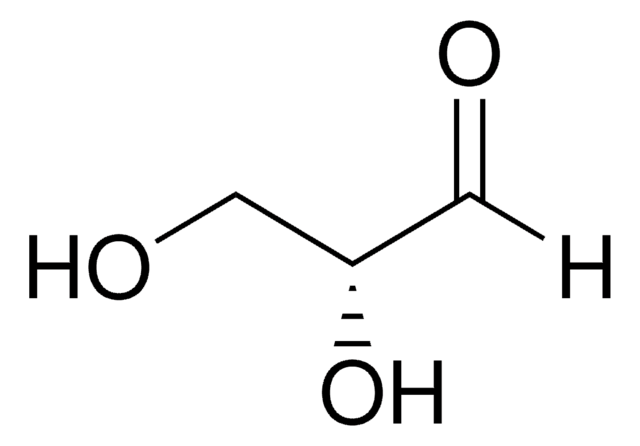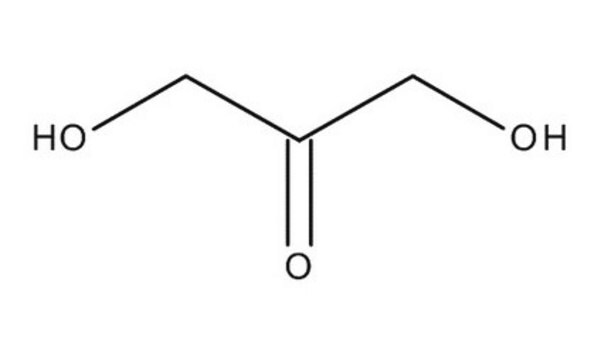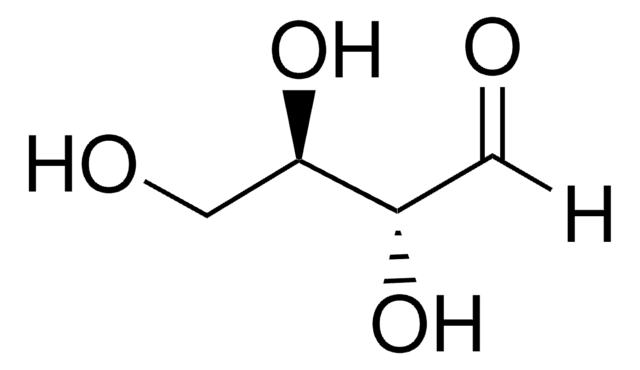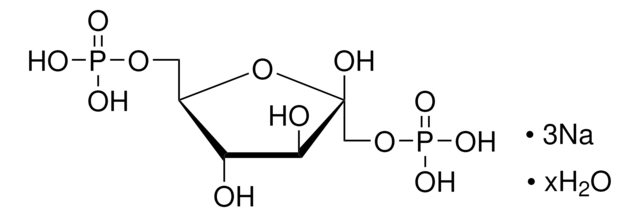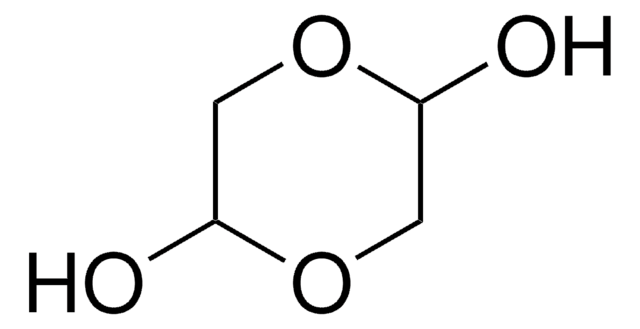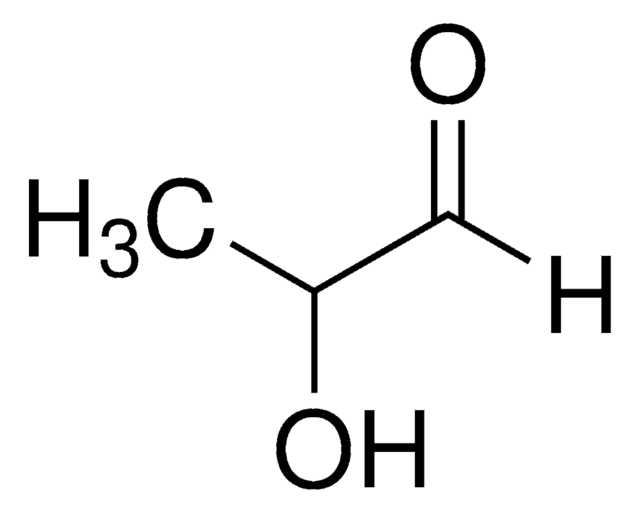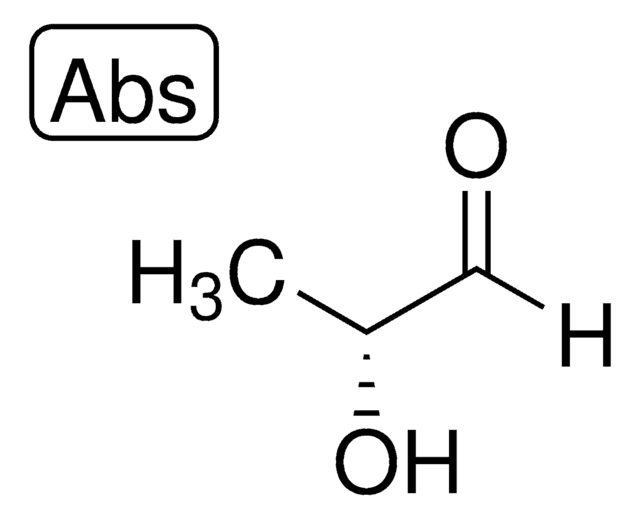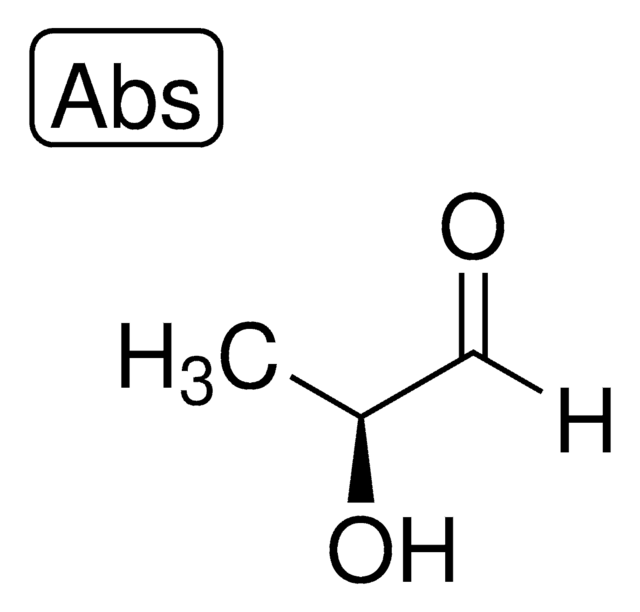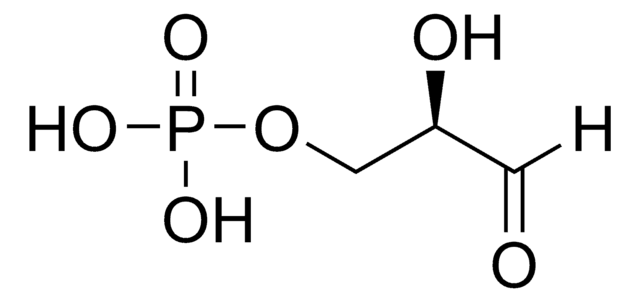おすすめの製品
品質水準
アッセイ
≥90% (HPLC)
光学活性
[α]/D -11.0±3.0°, c = 2 in H2O (after 24 h)
溶解性
water: soluble 30 g/L at 18 °C
保管温度
2-8°C
SMILES記法
OC[C@H](O)C=O
InChI
1S/C3H6O3/c4-1-3(6)2-5/h1,3,5-6H,2H2/t3-/m1/s1
InChI Key
MNQZXJOMYWMBOU-GSVOUGTGSA-N
類似した製品をお探しですか? 訪問 製品比較ガイド
アプリケーション
- L-Glyceraldehyde Inhibits Neuroblastoma Cell Growth via a Multi-Modal Mechanism on Metabolism and Signaling.: This research highlights the inhibitory effects of L-Glyceraldehyde on neuroblastoma cell growth, revealing its impact through multiple pathways in metabolism and cell signaling (Forbes M et al., 2024).
生物化学的/生理学的作用
L-(-)-Glyceraldehyde is an important intermediate in carbohydrate metabolism.
包装
底の開いたガラス瓶内容物は内部に挿入され接着された円錐部に入っています。
その他情報
To gain a comprehensive understanding of our extensive range of Monosaccharides for your research, we encourage you to visit our Carbohydrates Category page.
保管分類コード
10 - Combustible liquids
WGK
WGK 3
引火点(°F)
233.6 °F - closed cup
引火点(℃)
112 °C - closed cup
適用法令
試験研究用途を考慮した関連法令を主に挙げております。化学物質以外については、一部の情報のみ提供しています。 製品を安全かつ合法的に使用することは、使用者の義務です。最新情報により修正される場合があります。WEBの反映には時間を要することがあるため、適宜SDSをご参照ください。
消防法
第4類:引火性液体
第三石油類
危険等級III
非水溶性液体
Jan Code
73572-1G:
73572-250MG:
73572-50MG-BULK:
73572-50MG:
73572-VAR:
73572-250MG-BULK:
73572-BULK:
73572-1G-BULK:
最新バージョンのいずれかを選択してください:
この製品を見ている人はこちらもチェック
David A Korasick et al.
Journal of molecular biology, 431(3), 576-592 (2018-12-24)
Heterokonts, Alveolata protists, green algae from Charophyta and Chlorophyta divisions, and all Embryophyta plants possess an aldehyde dehydrogenase (ALDH) gene named ALDH12. Here, we provide a biochemical characterization of two ALDH12 family members from the lower plant Physcomitrella patens and
Nina Richter et al.
Biotechnology and bioengineering, 106(4), 541-552 (2010-03-04)
A whole-cell catalyst using Escherichia coli BL21(DE3) as a host, co-expressing glycerol dehydrogenase (GlyDH) from Gluconobacter oxydans and glucose dehydrogenase (GDH) from Bacillus subtilis for cofactor regeneration, has been successfully constructed and used for the reduction of aliphatic aldehydes, such
Cancer biomarker AKR1B10 and carbonyl metabolism.
Balendiran, G. K., et al.
Chemistry & Biology, 178, 134-137 (2009)
Nina Richter et al.
Chembiochem : a European journal of chemical biology, 10(11), 1888-1896 (2009-07-07)
The acetic acid bacterium Gluconobacter oxydans has a high potential for oxidoreductases with a variety of different catalytic abilities. One putative oxidoreductase gene codes for an enzyme with a high similarity to the NADP+-dependent glycerol dehydrogenase (GlyDH) from Hypocrea jecorina.
Takanori Matsui et al.
Cardiovascular diabetology, 14, 1-1 (2015-01-15)
We have previously shown that serum levels of glyceraldehyde-derived advanced glycation end products (Gly-AGEs) are elevated under oxidative stress and/or diabetic conditions and associated with insulin resistance, endothelial dysfunction and vascular inflammation in humans. Further, Gly-AGEs not only evoke oxidative
ライフサイエンス、有機合成、材料科学、クロマトグラフィー、分析など、あらゆる分野の研究に経験のあるメンバーがおります。.
製品に関するお問い合わせはこちら(テクニカルサービス)